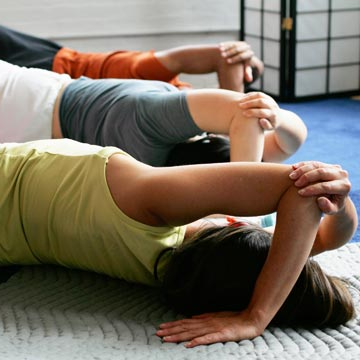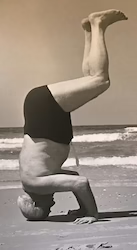Feldenkrais Awareness Through Movement® lessons are a unique kind of mindful movement carefully crafted series of movements that use particular strategies guaranteed to improve your function. The strategies take advantage of your nervous system’s innate braininess and are unusual even counterintuitive for most new students of the work.
Also, skip forward to view hints on Zoom classes.
Here are some tips to help you take advantage of what Awareness Through Movement has to offer:
1. Always begin with a moment or two of settling.
To tap into the wisdom of your nervous system, you’ll need to shift out of your usual, day-to-day busyness. Take a moment to lie on the floor, or in some other comfortable position, and notice how you are. Nothing profound needs to happen. Just allow your attention to move from all of the distractions of life the sounds and sights outside you to how you are, right now. Listen to your breathing, your contact with the floor, your mental and emotional state, and enjoy the pause.
2. Adopt an attitude of friendliness toward yourself.
Once you’ve settled, resolve to treat yourself carefully during the lesson. Some people think of this as being friendly or gentle with themselves. Whatever words you put to it, it is important explore the movements of the lesson without criticism. Sometimes I think of this criticism, or judgment as “color commentary” the stream of thoughts that our minds can produce to comment on anything we do. Take a break from that during the lesson, and just listen.
3. Never do anything that increases discomfort.
Feldenkrais lessons never have to hurt and never should hurt. During the lesson, if there are movements that sound like they will hurt you, try imagining the movement before you do anything. Then, imagine it again, or do the safe part of the movement, or move so slowly that you can easily stop before you get to the part of the movement that is painful. Students often find that if they follow these suggestions, they can do far more than they suspected.
4. Move slowly.
The object of these lessons is to learn. Anyone can learn from the lessons, but everyone is different and learns at their own rate. Take plenty of time, move slowly, and allow yourself to become familiar with the movement by repeating it in various ways. As you gain a mastery of the movements, they will automatically become faster and more powerful with an ease that may surprise you.
5. Do what is pleasant.
Human beings naturally move toward pleasure. If you take your time and learn what is pleasant, your function will improve. In today’s world, this approach may seem counterintuitive, but any other approach fights against the basic organization of our nervous system.
If you are used to movement being exercise with a “no pain, no gain” approach, doing what is pleasant may be a challenge. Give it a try. An hour is not too long to take care of yourself and to enjoy moving..
6. Move small.
Our senses can perceive very small differences. When moving, it is easier to notice what you are doing if movements are small. Have you ever moved too quickly and bumped into something you knew was there? If your movements had been smaller, you would have been able to make the differentiations that allow you to negotiate your place in space with more precision and safety.
This is not to say that you should always move slowly or with small movements. Life often calls for speed and power. But to develop the best possible form, the way of moving that is most efficient and functional, we must learn what is best for us. Old habits can be improved, but only when we slow down and move in a way that allows us to notice and learn.
7. Never go to the end of your range of movement.
It may seem counterintuitive, but never do as much as you can in an Awareness Through Movement lesson. You will learn if you give yourself the time and space to experiment, but not if you do the same things in the same way. Once you go to your limit, you are done. If you do less, you open a space for improvement.
8. During the lesson, do some of the movements in your imagination only.
Practicing movements mentally can have amazing results. As you learn to imagine more and more clearly, feeling muscles mobilize and bones prepare to move, you will gain mental control and flexibility. Imagining the movements will help you transfer the benefits of the lessons to other areas of your life.
9. Don’t worry.
You really can’t do this work wrong, unless you insist upon hurting yourself. If you stay within your realm of comfort, you’ll do fine. Remember, you are not exercising, or trying to get some position “right.” You are learning how to be a more functional and mature human being. Trust your amazing brain and nervous system to figure out what is right for you.
10. Ask for help when you need it. Take advantage of Functional Integration®, the individual Feldenkrais “hands-on” lessons.
There are two halves to the work: Awareness Through Movement and Functional Integration. As you work your way through the voice-guided Awareness Through Movement lessons, you may occasionally want to speed up your progress or have the benefit of a movement expert to explore a movement or function. That’s when you will want to take advantage of the other half of the work: movement guided by touch in a Functional Integration lesson, sometimes called an individual lesson.
You can learn to dance in a class of beginners, but if you want to progress faster, you’ll want to dance with a great partner. That’s the way individual lessons work. You’ll get completely individualized attention and movements guided by the expert’s touch that are exactly what your system needs.
There are many movements that you could do easily, but will never experience on your own because of your old movement patterns. In an individual lesson, you can experience the pleasure of moving in new and comfortable ways. Individual lessons are safe for everyone, even those currently having acute episodes of pain, and often decrease or eliminate aches, pain, and stiffness.

Here are some things you can do to have a successful ZOOM class:
Join before class time. Once the class starts I like to keep going and not review all that has already been done. By joining in advance you can settle in and relax. Those who join late often tell me they felt rushed and extra tense and it took them some time to allow the benefits of the class.
Ensure you have stable wifi. Sometimes people’s wifi freezes and they miss some instruction. Or it drops out and they have to re-start the equipment. This interferes with the ease and comfort in the lesson.
Ensure your audio will be loud enough. The audio on some computers can be a little quiet — check yours out in advance so you won’t have to strain. Some people have used bluetooth headphones successfully.
Generally, you don’t have to see the screen. Although there will be time for discussion, once the class starts, you will be listening to instructions and following them. If you are a bit confused and are not sure the position, raise your hand in a way I can see it — then we can work together so you understand.
Help me see you. Position your camera so I can see you. That makes a big difference as I am observing participants as they are interpreting the directions. It is best if the camera is at least 4 feet (3.3 meters) above the floor, preferably to your side, and angled downward.
Miss a Class? Use the Recording! The lessons are recorded, and are posted usually within a few hours of the end of the class to this site.






